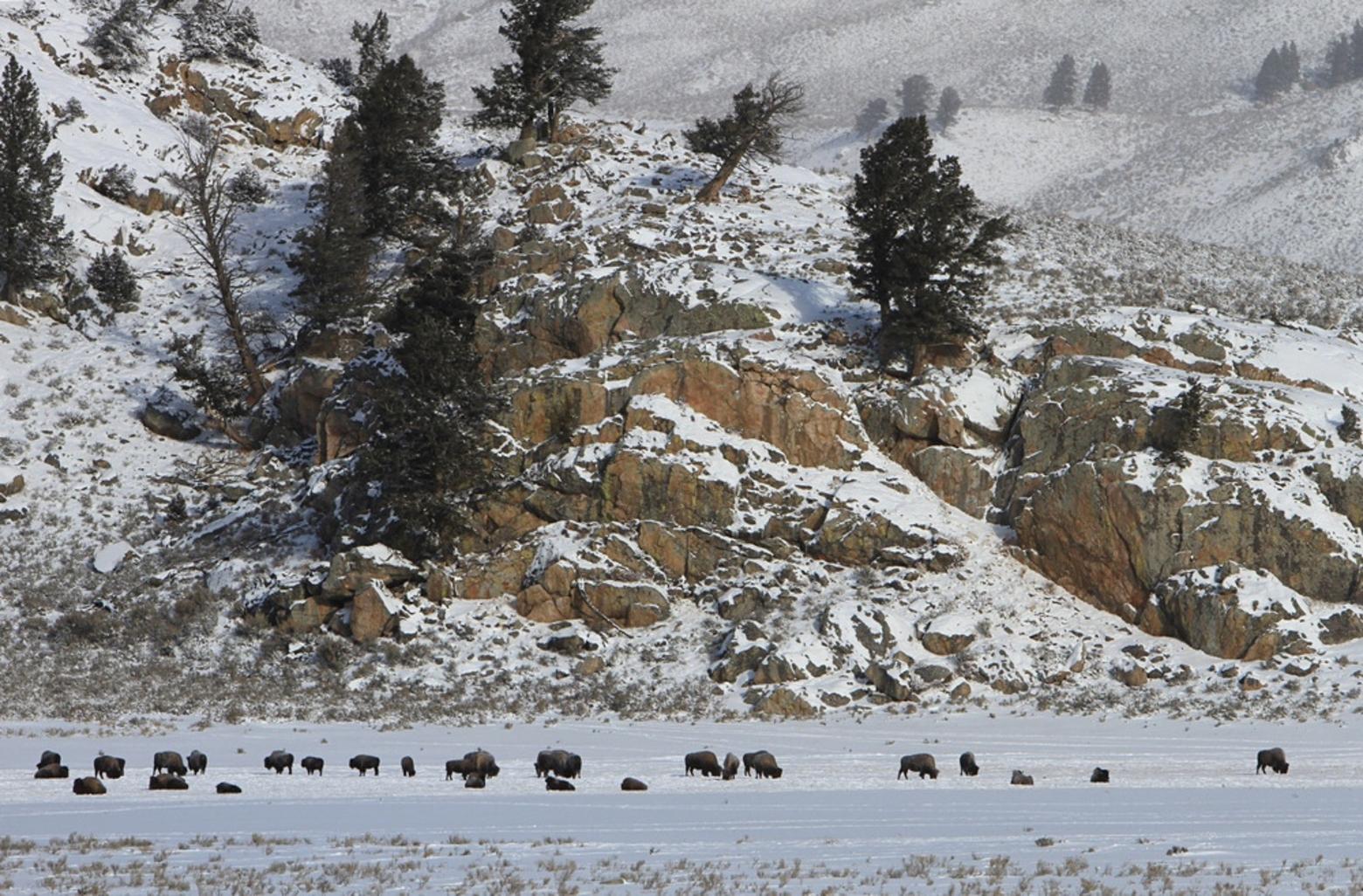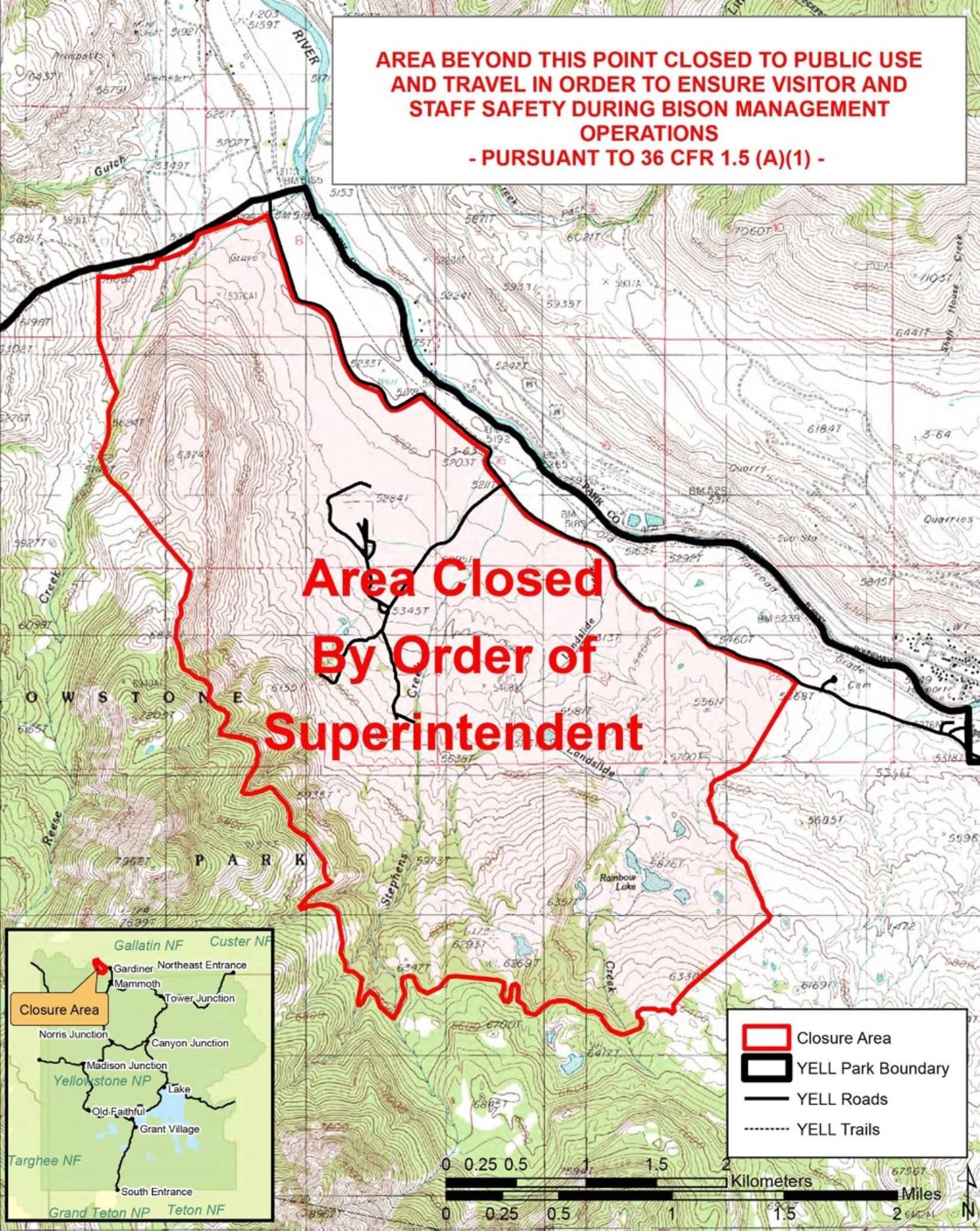Back to StoriesYellowstone Investigates Illegal Release of 52 Park Bison From Quarantine
January 17, 2018
Yellowstone Investigates Illegal Release of 52 Park Bison From QuarantinePark officials says criminal trespass undermines effort to get animals transplanted on native reservations
Yellowstone National Park law enforcement officials are now
investigating possible criminal trespass and tampering that resulted in the
release of 52 wild bison being held in quarantine at the park’s Stephens Creek
corral facility located just inside Yellowstone’s northern border.
The acts, which occurred sometime prior to the morning of
Tuesday, January 16, are seen as a setback to efforts by Yellowstone to keep
more migrating park bison alive and potentially used as seed stock to build a
new wild herd on the Fort Peck Indian Reservation as well as other potential
release sites in the future.
Park spokesman Morgan Warthin said that because of the active investigation more details could not be shared. However, she noted that
the illicit action disrupted a quarantine process rapidly progressing toward
clearing bison for being transplanted on the northern Montana prairie.
According to a binding, court-ordered agreement between the
state of Montana, Yellowstone and the federal Animal and Plant Health
Inspection Service, bison that wander into Montana can normally be killed to
prevent them from potentially coming in contact with domestic cattle.
Such lethal management, part of the Interagency Bison
Management Plan enacted 18 years ago, has been carried out under the premise
that bison pose an imminent threat to passing the bovine disease, brucellosis,
to livestock. Yet, as a report released by the National Academies of Sciences
noted in the summer of 2017, there has never been a confirmed case of wild
Yellowstone bison transmitting the disease to cattle; nonetheless, more than
10,000 Yellowstone bison have been killed or sent to slaughter since the 1980s,
sparking outrage among conservationists.
Read Mountain Journal's story on the Yellowstone bison controversy involving the state of Montana and the debate about brucellosis.
In an attempt to spare some bison from destruction,
Yellowstone Superintendent Dan Wenk instructed his staff to capture some bison, hold them under
quarantine to make sure they are not potential disease carriers and then make
them available to tribes that want to bolster or establish bison herds.
Following the acts by yet-unknown trespassers who illegally
released the 52 bison from two Stephens Creek pens, none of the liberated animals have yet been
recaptured. The irony is that some of them, as a part of a park plan that calls
for killing potentially several hundred bison this winter to reduce animal
numbers inside the park, may now be subject to hunting, lethal culling or shipment
to slaughter.
“This
is an egregious criminal act that sets back bison conservation. It delays
critical ongoing discussions about a quarantine program and the transfer of
live Yellowstone bison to tribal lands,” Wenk said in press release. “The park
is aggressively investigating this incident.”
"The criminals who broke into a national park facility to release these bison put at risk the safety of the animals that are now at risk of being culled and our park rangers who are rounding them up." —Interior Secretary Ryan Zinke
Referencing the quarantine regimen, the park added, “The purpose of that
[quarantine] program would be to augment or establish new conservation and
cultural herds of disease-free plains bison, enhance cultural and nutritional
opportunities for Native Americans, reduce the shipment of Yellowstone bison to
meat processing facilities, and conserve a viable, wild population of
Yellowstone bison.”
In
the same news release, Interior Secretary Ryan Zinke was also quoted, “I am
absolutely heartbroken for the Fort Peck Tribes who have been working with the
park, the state of Montana, and Animal and Plant Health Inspection Service for
years to repatriate these bison," Zinke said. "The criminals who
broke into a national park facility to release these bison put at risk the
safety of the animals that are now at risk of being culled and our park rangers
who are rounding them up. I will be working with [U.S. Agriculture] Secretary
Perdue to see if we can get back on track to transfer the brucellosis free
bulls to the tribe this year."
Another irony is that secretaries Zinke and Perdue hold the authority to give bison room to roam outside the park now that the National Academies' report demonstrated that the overwhelming risk of brucellosis transmission is from elk, not bison. Beyond Yellowstone/s boundaries, the U.S. Forest Service, an agency under Perdue's command at the Agriculture Department, could allow for bison movement out both the north and west sides of Yellowstone, including into the Taylor Fork drainage which the state of Montana has acknowledged would be suitable for a small subherd that could be subject to a limited hunt.
This
is the second time in a decade that trespassers have freed bison from
quarantine. In the wake of the latest incident, Wenk issued a closure of the
area around Stephens Creek to all public use.
Until
a new Interagency Bison Management Plan is completing, the old one remains in
effect and it calls for inclusion of the tribes in management decisions since,
under historic treaty, consultation with tribal governments is required.
The
Buffalo Field Campaign, a bison protection group based near West Yellowstone,
Montana issued its own press release Wednesday and claimed that if Interior
Secretary had plans for moving bison to Fort Peck it was news to the tribe. Ft. Peck Tribal Chairman Floyd Azure said he
wasn’t aware of any imminent shipment of Yellowstone bison.
Mike
Mease and Stephany Seay of the Buffalo Field Campaign said that just because
bison are in quarantine it does not guarantee animals will not be shipped to
slaughter. Some 24 Yellowstone bison
were placed in quarantine pens since march 2016 and another 28 were added to
the facility in March 2017.
“All of the female buffalo who had been part of
that capture-for-quarantine were shipped to slaughter last year when
Yellowstone opened the trap to begin slaughter operations,” they stated. “All
of the buffalo who remained in the then-unapproved quarantine facility were
bulls. Seven of these bulls have been shipped to slaughter or have died
due to human handling.”
The Buffalo Field Campaign is among more than
half a dozen wildlife conservation groups that have pressed for the new bison
management plan to allow animals to range on public lands outside the national
park.
Regarding the alleged criminal trespass incident,
park spokesman Warthin said that anyone with information is encouraged to call
the Yellowstone National Park Tip Line at 307-344-2132, email Yell_LEO@nps.gov or visit http://go.nps.gov/tipline.
Related Stories
August 20, 2018
Yellowstone Checkup: How Healthy Really is America's Most Iconic Wildland Ecosystem?
New "vital signs" report says region's famous wildlife faring well, for now, but climate change and human development loom ominously
October 2, 2021
Scientists Say Gianforte's Anti-Wolf, Anti-Grizzly Policies In Montana Have No Scientific Basis
Prominent group of wildlife professionals with 1,500 years of experience condemn Montana's new laws targeting wolves. Already pups from popular Yellowstone...
June 7, 2018
Forced Out Of Yellowstone
Despite Yellowstone Superintendent Dan Wenk’s desire to end his 42-year-career in America’s first national park, Ryan Zinke’s Interior Department demands he...



